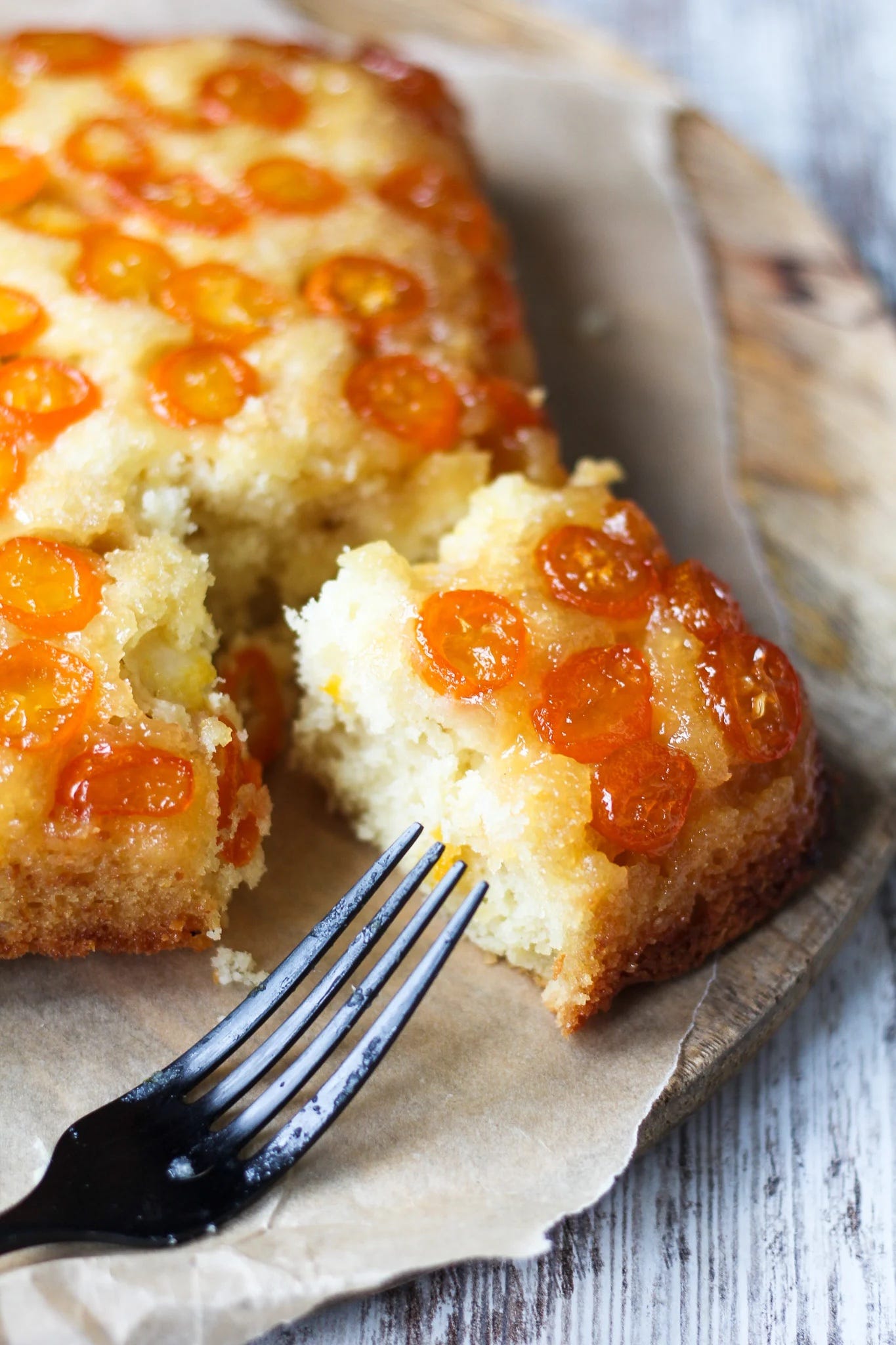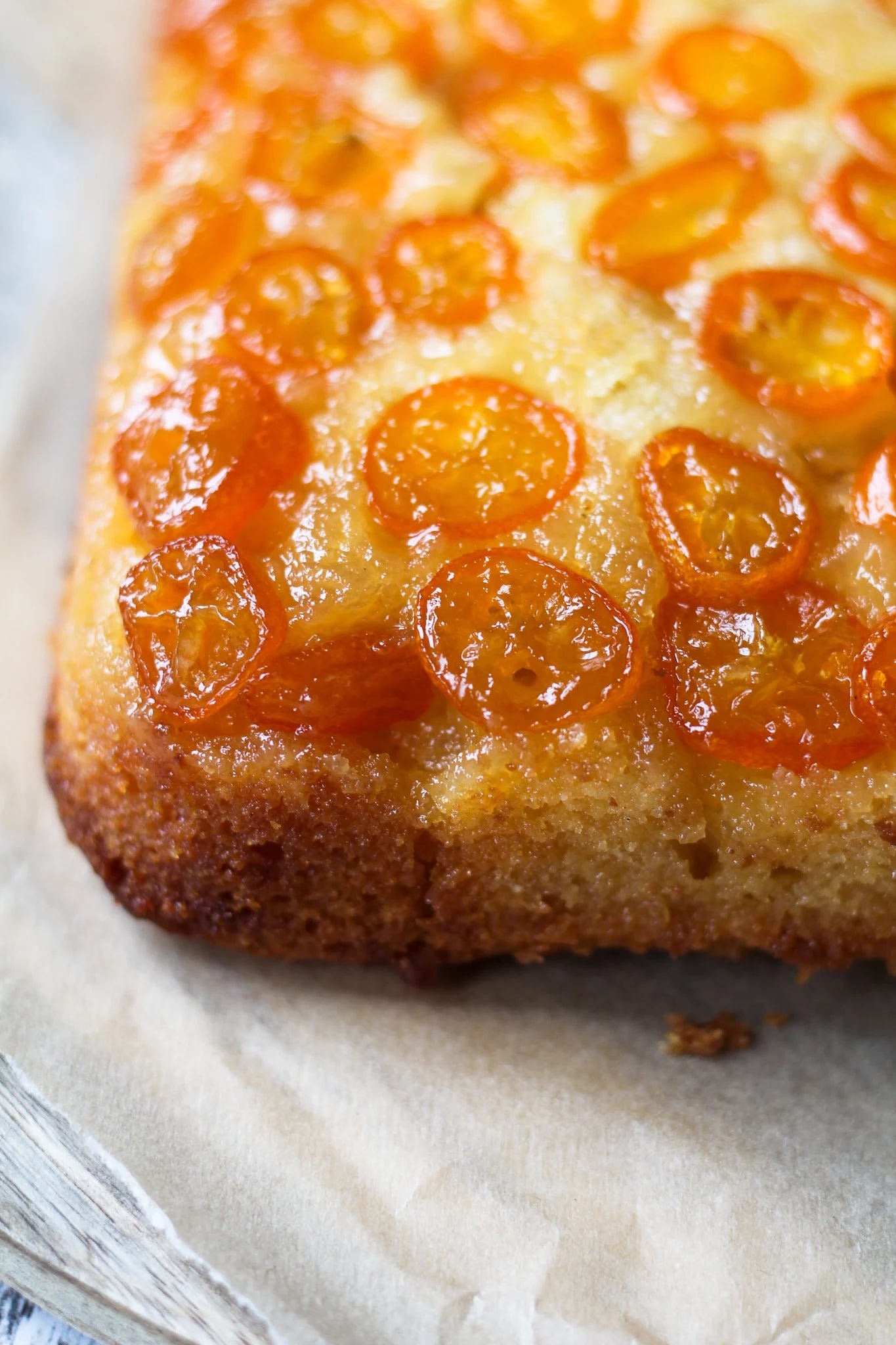Recette en français ici
Kumquat season is almost over. In France, these little winter fruits are available from December to March. Their taste is zesty and unique. The thin, soft, sweet peel perfectly balances the tart, sometimes bitter flesh of this surprisingly juicy fruit.
Their acidity pairs beautifully with the sweetness and softness of an upside-down cake. This type of cake can be made with almost any fruit, as long as it holds up during baking and caramelizes nicely. The most famous version is, of course, the pineapple one — but you can easily get more creative by using mango, blueberries, or even… kumquats.
Most recipes you'll find are very (too!) sweet and rich. I tested several versions before finding the right balance between sugar and butter. No more, no less: here’s a recipe that requires no tweaking on your part.
Ingredients
Makes 8 slices.
For a 20 cm / 8-inch cake pan:
30 g unsalted butter
30 g cane sugar
About 10 kumquats
100 ml almond milk
150 g all-purpose flour
50 g almond flour
1 tsp baking powder
2 eggs
40 g fine cane sugar (grind it into a powder first — otherwise, you’ll feel the grains after baking. I learned this the hard way!)
50 g unsalted butter
A pinch of salt
1 plain Greek yogurt (150 g)
Instructions
Preheat your oven to 180°C (350°F).
In a saucepan over medium heat, melt 30 g of butter and 30 g of sugar until the mixture bubbles.
Meanwhile, thinly slice the kumquats, separating the round slices from the little end caps.
Line your cake pan with parchment paper (important for this moist cake to hold together), and trim any overhanging edges — they can burn in the oven (yep, it happened to me!).
Arrange the kumquat slices neatly at the bottom of the pan, filling every gap.
Once your sugar-butter mix is bubbling, pour it gently over the kumquats to coat the bottom of the pan.
Put the saucepan back on low heat, add the almond milk and the kumquat end caps, and let steep for about 30 minutes, stirring occasionally.
In a bowl, mix the flour, baking powder, and almond flour.
Separate the egg yolks from the whites.
In a separate bowl, cream together 40 g of sugar, 50 g of previously melted butter, and a pinch of salt. Then add the Greek yogurt and the 2 egg yolks.
Fold the dry ingredients into the wet mixture until smooth.
Using a strainer, gradually pour the kumquat-infused milk over the mixture, stirring between each addition to incorporate it well. Discard the kumquat tops.
Whip the egg whites until stiff peaks form.
Gently fold them into the mixture. (See: “How to fold egg whites into cake batter?” in Kitchen Secrets below.)
Pour the batter over the kumquat slices, then bake at 180°C (350°F) for about 30 to 35 minutes (baking time may vary depending on your oven). To check if it’s done, insert the tip of a knife into the center of the cake — it should come out clean or slightly moist, but without any raw batter.
Let the cake cool for about ten minutes, then turn it right side up onto a plate. Carefully remove it from the mold, then gently peel off the parchment paper, taking care not to damage the cake.
Place the cake back in the oven, this time right side up, for 10 minutes at 150°C (300°F).
Then let it cool for 10 to 20 minutes before serving.
Nutritional Bonus
Packed with good fats, protein, and fiber thanks to the eggs, almond flour, and Greek yogurt. Kumquats add a splash of vitamin C and brightness. This cake is nourishing, gentle on digestion, and naturally sweet.
Vitamins: A, B2, B6, C, D, E
Storage Tips
At room temperature: Store in an airtight container or wrapped tightly in plastic wrap. Stays moist for up to 3 days.
In the fridge: Keeps for up to 1 week. Let it sit out 30 minutes before eating to regain its texture, or microwave briefly to warm it.
In the freezer: Slice the cake, wrap each piece individually, and freeze for up to 3 months. Defrost at room temperature or reheat gently in the microwave.
Kitchen Secrets
Enjoy with a glass of almond milk, citrus black tea, fresh blood orange juice, or a glass of Prosecco.
How to fold egg whites into cake batter?
Whip your egg whites until stiff peaks form, the tip should hold its shape and stand straight on the whisk without dripping.
Add one large spoonful of the whipped egg whites to your batter and mix it in vigorously. This helps to loosen the batter, which is often quite thick.
Then, gently fold in the remaining egg whites in two or three additions using a spatula. Lift the batter from the bottom and fold it over the top while rotating the bowl. Avoid stirring in circles like you would with a whisk — that would deflate the egg whites.
The mixture should be almost uniform but not perfectly smooth like a classic batter. It’s normal (and even good!) if you still see a few white streaks.
A comment a day keeps my ego crisis away.







I'll try this with pineapple when I get home ☺️